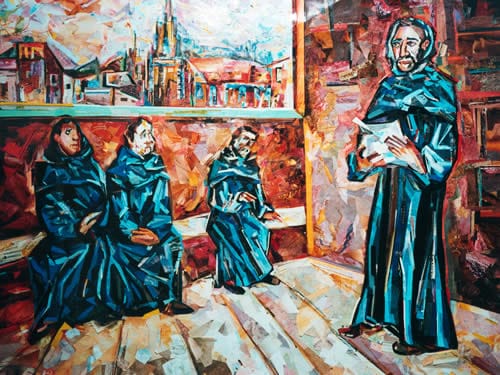The Augustinian Recollects were born in the year 1588 in Toledo, in the Provincial Chapter of the Augustinians, Province of Castille, and as stated in the fifth definition of this same Provincial Chapter, as a group of religious who, “desirous of monastic perfection, desire to follow a more austere plan of life”. The same Chapter entrusted the redaction of norms that would govern the kind of life of this new group of Recollects to the provincial council. The council, in turn, delegated said work to Fray Luis de León and Jerónimo de Guevarra. The latter died early, in Easter of 1589; this is the reason why to Fray Luis de León is attributed the authorship of the document, known as Forma de Vivir, which regulates the life of the Recollect convents. It was also Fray Luis de León who presented it to the intermediate Chapter that was celebrated in 1589 in the convent of Our Lady of the Pine. According to Juan de Quijano, contemporary of Fray Luis, it was the same Fray Luis who mostly animated the founding of Recollect houses.
Desire of Perfection
The Forma de Vivirhas 14 chapters, which were approved by the Province of Castille on the 17th of September 1589. Pope Clement VIII approved it later, in 1597. Although the text of the Forma de Vivirwas in force for forty years (it was substituted in 1637 by more elaborate constitutions), its spirit, far beyond the letter of the text, captures and reflects the desire of the “monastic perfection” that will perpetuate, through the centuries, the religious family of the Recollects. In this manner two transversal lines, within the text of the Forma de Vivir, give it cohesion and meaning: prayer and common life.
The life of the first recollects was oriented to foment every thing that will keep the religious “ablaze with the love of God” and make him remember that his principal “goal and purpose” is to love God. What was sought for was greater intimacy with God, in such a way that the diverse activities of the day are not obstacles, but elements that will facilitate and promote continual dialogue of the religious with God.
Prayer and Retirement
Everything in the recollect life ought to invite to recollection, to interior retirement. Exterior retirement is converted into an element that facilitates and favors interior retirement. In the Forma de Vivirapostolate is not rejected, but is limited and determined, in order that the religious will not, under the pretext of pastoral work, look for excuses to go out away from interior retirement or from the exterior environs of the convent. The daily two-hour mental prayer does not pretend any other thing but to point to, on one part, the importance of personal prayer and, on the other part, the profound need the recollect religious has to perceive God, in a way that these two hours become not an onerous demand, but minimum a need for each religious.
Community Life
But the exacting rhythm of prayer does not convert the recollect into a hermit. Prayer, following authentic Augustinian tradition, opens the religious to the encounter with God in the brother within the community. The Forma de Vivirwould insist much on the life of the community, it would even govern recreations, times of dialogue with the brothers, and the space to manifest with simplicity and joy the fact of having one soul and heart oriented toward God, living in harmony, since “peace among the religious themselves, is sure sign that the Spirit lives among them”. And to favor interpersonal relations in the community, the Forma de Vivirlimits the number of religious to 20, conscious that “love is better kept among few”. In recollect communities privileges and differences among the religious are set aside, the usage of exemptions and private purse or property are banished. All are equal in the convent. No one can dispose of any of his property, and the food, clothing and cell are the same for all.
Ascetic Life
One will find that asceticism is an element that helps the religious live prayer and strengthens the life of the community. The Forma de Viviris imbued with ascetical norms and dispositions, from fasting and mortifications to disciplines, silence and the retirement. The Forma de Vivir, child of its own time, puts great interest in underscoring these ascetical elements, but without losing sight of its ordinance toward the life of prayer and community, where essentially the Augustinian accent is found.
On the other hand, it is true that in the XVI century there was little information about the life of St. Augustine and of the Augustinian communities. There was the attempt to present Augustine as an ascetic hermit, and consequently, the external imitation of his kind of life had to do with the practices of the hermits at that time, that is, austerity, silence, solitude, and ascetical practices. There are, nevertheless, in the Forma de Vivir, ideas that one cannot but perceive and which are deeply intertwined with the Augustinian roots, like the primacy of charity and the fraternal life of the community.
Charismatic Referece
In spite of the four hundred years in between us and the text of the Forma de Vivir, its spirit is alive and its essence – much beyond the accidental elements and which require historical hermeneutic – remains in force as charismatic reference for all Augustinian Recollect communities.


